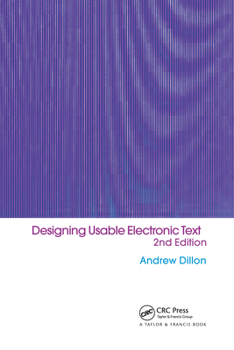Designing Usable Electronic Text: Ergonomic Aspects of Human Information Usage
Select Format
Select Condition 
Book Overview
Electronic documents offer the possibility of presenting virtually unlimited amounts of information to readers in forms which can be rapidly searched and structured to suit their needs. However, poor... This description may be from another edition of this product.
Format:Hardcover
Language:English
ISBN:041524059X
ISBN13:9780415240598
Release Date:January 2004
Publisher:CRC Press
Length:224 Pages
Weight:0.98 lbs.
Dimensions:0.7" x 6.1" x 9.2"
Related Subjects
Administration & Medicine Economics Computer Science Computers Computers & Technology Education & Reference Electrical & Electronics Engineering Games & Strategy Guides Human-Computer Interaction Industrial Engineering Industrial, Manufacturing & Operational Systems Internal Medicine Language Arts Medicine Occupational Public Health Science & Math Technology Textbooks Web Development & DesignCustomer Reviews
2 ratings
Accessible, Thorough and Useful
Published by Thriftbooks.com User , 25 years ago
I'm researching systems-development related topics at the moment and this book is one of the few I've encountered that gives an abundant amount of carefully considered information. Most books, it seems, can be summarized in a sentence or two. Dillon's work, on the other hand, is one of the most detailed--and purposeful--I've seen. I'd recommend this book not only to text designers but anyone interested in user-centered design. Its implications for users (who are often scanners, not readers!) are broad and significant, encompassing motivations (why people read, or why they visit websites and what they expect to get out of their experience) and navigation and wayfinding issues. Another useful component of the book is its discussion of using models and frameworks as a tool to faciliate structured research and development. Many thanks to Dillon for providing a first rate book on a pervasive, yet largely ignored topic. I look forward to seeing more of his work in the future.
Best analysis of reading electronic text I have seen
Published by Thriftbooks.com User , 26 years ago
This is by far the best analysis of reading of electronic text that I have seen. He provides an excellent insight as to what is, what might be, and what is not important for on-screen reading. He does not limit text to just fiction/non-fiction categories, but instead discusses: WHY it is read professional/personal reasons, to learn or not, out of interest/need, etc. WHAT type of information it contains technical or non-technical, subject matter, general or specific, textual or graphic, etc. HOW it is read serially or non-serially, once or repeatedly, browsed or studied in depth, etc.His book suggests to me that text should alter its format to the meet the users - Why, What, and How. Possible examples: switch to all caps when searching for words or phrases, turn off hyperlink indicators for linear reading, ...He points out that there have been many studies on editing text, but few on reading text. A good fraction of the book deals with on-screen reading.Screen reading was better with: high resolution characters, increased space between lines (leading), proportional font, limiting the number of characters on a line, and not splitting a sentence across a page boundary. He indicates that users preferred on-screen reading over paper reading for some tasks when the screens had enough improvements.Screen reading might be improved with: landmarks/navigation, serif fonts, full left/right justification, ...Screen reading was no different than paper reading for: orientation of the media, flicker rate, screen dynamics, and visual angles (< 36 degrees).





